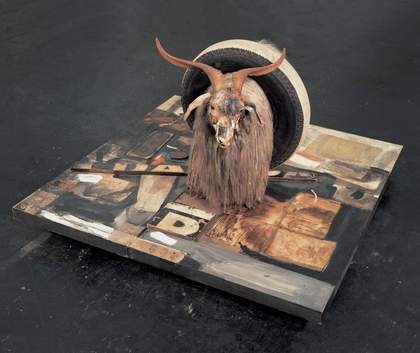
Robert Rauschenberg
Monogram 1955–59
Medium Oil, paper, fabric, printed paper, printed reproductions, metal, wood, rubber shoe heel,
and tennis ball on canvas with oil on Angora goat and rubber tire on wood platform
mounted on four casters
Dimensions 1067 x 1607 x 1638 mm
Moderna Museet, Stockholm
Moderna Museet (Stockholm, Sweden)
ROBERT RAUSCHENBERG
1 December 2016 – 2 April 2017
Global Sponsor Bank of America Merrill Lynch, Supporting Sponsor Tiffany & Co. and supported by Terra Foundation for American Art and Art Mentor Foundation Lucerne, with additional support from the Robert Rauschenberg Exhibition Supporters Group, Tate Americas Foundation and Tate Patrons
Tate Modern, The Eyal Ofer Galleries
Open daily 10.00 – 18.00 and until 22.00 on Friday and Saturday
For public information call +44 (0)20 7887 8888, visit tate.org.uk, follow @Tate #Rauschenberg
Tate Modern’s major exhibition of the work of Robert Rauschenberg (1925-2008), organised in collaboration with The Museum of Modern Art in New York, is the first posthumous retrospective and the most comprehensive survey of the artist’s work for 20 years.
From his early engagement with pop to his works produced at the dawn of the twenty-first century, Robert Rauschenberg blazed a new trail for art. Moving between painting, sculpture, photography, print-making, technology, stage design and performance, he refused to accept conventional boundaries in art and in life. Rauschenberg’s quest for innovation was fired by his openness to the world, his enthusiasm for collaboration and his passion for travel.
Each chapter of Rauschenberg’s six-decade career is represented by major international loans that rarely travel. Among these is a selection of his iconic Combines, hybrids between painting and sculpture, which include Monogram 1955-59, travelling to the UK for the first time in over half a century, and Bed 1955. Tate Modern is also showing the signature silkscreen paintings that signalled Rauschenberg’s attempt to bring politics, mass media imagery and street scenes into his work, including Retroactive II 1964, which portrays John F. Kennedy, who had recently been assassinated.
The exhibition begins by considering Rauschenberg’s early experiments at Black Mountain College, a hotbed for innovation in the late 1940s and early 1950s where he embarked on his first collaborations with fellow artists and friends John Cage, Merce Cunningham, Jasper Johns, David Tudor, Cy Twombly and Susan Weil. This time led to his seminal Erased de Kooning Drawing in 1953, which paid tribute to the achievements of abstract expressionism whilst agitating the limits of what art could be. The artist’s work with Experiments in Art and Technology (E.A.T), an organisation of which he was a founder and which developed collaborations between artists and engineers in the 1960s, is also explored, showing how he helped to initiate new conversations between the visual arts, performance and science.
In the early 1970s Rauschenberg moved his studio and primary residence to Captiva, Florida and began to travel extensively across Europe, the Americas and Asia. His Cardboards 1971-2 – a wry comment on the forces of globalisation – and his sumptuous fabric works such as the Jammers 1975-6 – inspired by his visit to the Indian textile centre of Ahmedabad – demonstrate his skilful play with unconventional materials. The epic project Rauschenberg Overseas Culture Interchange (ROCI), a travelling exhibition which took place between 1984 and 1991 taking in Chile, China, Cuba and Tibet, is also featured.
Performance and dance remained key drivers for Rauschenberg’s approach to art making and form a central strand of the exhibition. Documentation of his collaborations with Merce Cunningham and Trisha Brown, as well as his own performance works will be included. On 27 and 28 January 2017, the renowned Trisha Brown Dance Company will re-stage her influential work Set and Reset using the original set and costumes created by Robert Rauschenberg in the Tanks. A number of rooms will also illustrate Rauschenberg’s interest in pushing the limits of image-making with new materials such as printing on translucent textiles, polished steel or tarnished aluminium. A striking group of late inkjet paintings, combining dozens of images taken at home and abroad through the use of digital technology, reveal how he continued to innovate right into the twenty-first century.
Robert Rauschenberg is organised by Tate Modern and The Museum of Modern Art, New York. It is curated by Achim Borchardt-Hume, Director of Exhibitions, Tate Modern; and Leah Dickerman, The Marlene Hess Curator of Painting and Sculpture, The Museum of Modern Art, New York; with Catherine Wood, Senior Curator, International Art (Performance), Tate Modern; and Fiontán Moran and Juliette Rizzi, Assistant Curators, Tate Modern. The exhibition will travel to The Museum of Modern Art in New York and the San Francisco Museum of Modern Art in 2017.
For press information contact cecily.carbone@tate.org.uk or kirsten.cowie@tate.org.uk
or call +44(0)20 7887 8731 / 4906. For high-resolution images visit tate.org.uk/press
